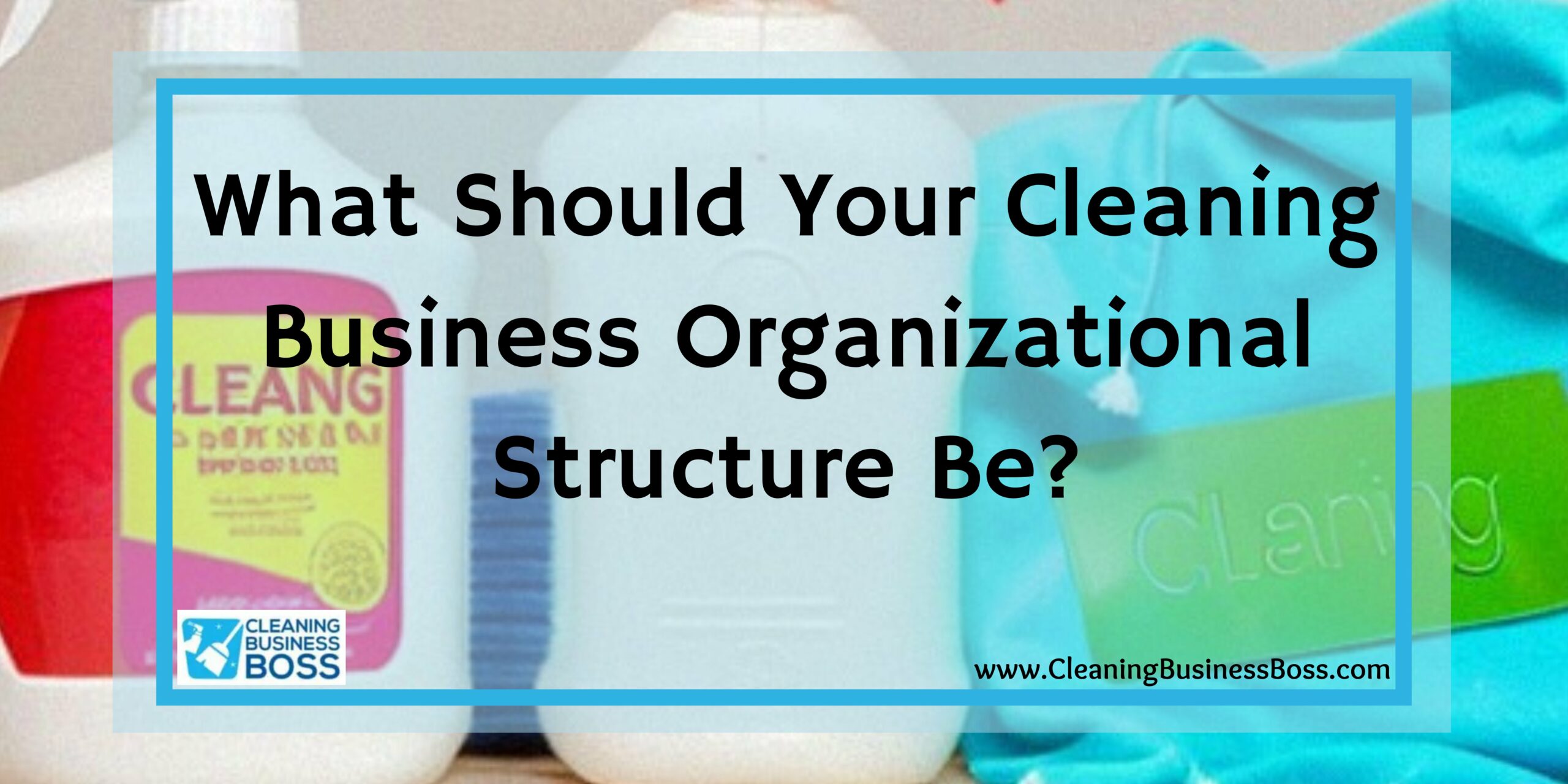Just like every other business, your new cleaning business needs an organizational structure to function effectively. Often, running a small business means the bulk of the job falls on you. However, if you want growth for your business, you must adopt an organizational structure. I will show you four possible organizational structures that you can adopt for your new cleaning business. At the end of the article, you’ll be able to pick the one that suits you best.
If you want to acquire and retain qualified staff to help share roles, you need an organizational structure that facilitates communication, outlines the lines of authority, and shows the team how to develop their careers and move up the ladder. Generally, there four common types of traditional organizational structures;
- functional
- divisional
- matrix
- flat
You can run your cleaning business based on any of these four organizational structures. However, it is essential that you understand each of them. That way, you’ll be able to make better business decisions.
Organizational Structure
The organizational structure is a graphic description of a company that explains what employees do, who they answer to, and how decisions are taken within the company.
Organizational structures may use roles, markets, services, or processes as guidance on how the business will be managed at a particular stage.
When your cleaning business expands, an organizational structure will also help new employees understand who oversees specific processes in the company.
Furthermore, should you choose to change or move your leadership, you will be able to visualize the workflow by modifying the organizational structure chart.
This chart is like a diagram that shows how the organization operates and how its roles are distributed.
Types of Organizational Structure

Functional structure
The functional structure is one of the most popular forms of organizational structure; it departmentalizes a company based on similar roles.
Adopting a functional structure for your cleaning business means all customer care reps will be in the same department, cleaning staff will be in the same department, logistics will be in another department, and so on.
The functional structure provides a higher level of specialization for staff and is easily scalable when your business expands.
This model is, however, mechanical in design and can limit the development of an employee. Also, placing workers in skill-based departments will also encourage them to further dig into their field and figure out what they are good at.
Cons
Functional design can often build gaps between various functions and may be ineffective if your company has a number of specific services or target audiences. The obstacles that have been generated between departments may also restrict the knowledge and contact of employees with other departments, especially those who rely on other departments to function.
Divisional Structure
The divisional organizational structure consists of several sets of smaller structures ( i.e., each unit of a divisional structure can have its customer care unit, its transport team, and so on). In this case, each divisional structure is committed to one service or product. For instance, you can have a section for home cleaning and another section for commercial cleaning.
Cons
It can be hard to balance a product-based divisional structure, and your company might end up with similar services to different departments work to create new services.
Matrix Structure
A matrix structure includes both horizontal and as vertical layers for reporting. Employees can sometimes join another functional group ( i.e. logistics) but also work on a team that facilitates the advertisement of new services ( i.e. promotional). This form of arrangement could include representatives from various teams working together to create a new service.
Cons
A benefit of a matrix organizational system is that workers have responsibilities not just for their team, but also for organizational tasks. However, when workers are given orders by two separate managers, a problem arises, as they’ll need to prioritize their primary job duties.
Flat Structure
Whereas a more conventional organizational structure may appear a little like a pyramid — with several layers of supervisors, managers, and directors between employees and leadership — the flat structure, on the other hand, reduces management tiers so that all workers are just a few steps apart from management.
This system is perhaps one of the most comprehensive, and it is often believed that workers will be more efficient in a setting where there is less hierarchical pressure. This arrangement may help staff believe their managers are more like colleagues or teammates than controlling bosses.
Cons
If there’s a situation where a disagreement pops up between team members in a flat structure, it can often be difficult to put things back in order. It mostly requires executive instruction to restore order.
Owing to the complexities of this structure, it can be difficult to decide which boss an employee will go to if they require permission or an executive opinion on anything. So if you want to create a flat structure, you’ll want a precisely defined management level or a direction that employees will follow as they run into certain situations.
Each of these organizational structures has a unique advantage and you must consider these factors before you decide to pick one for your business.
Building blocks of organizational structure

Chain of command
Your chain of command is how tasks are assigned and work is authorized. An organizational structure helps you to determine how many “ladder rungs” a certain department or line of business will have. In other words, who decides who’s going to do what? And how are problems, demands, and ideas conveyed up and down the ladder?
Span of Controls
Your control range can portray two things: who falls under the authority of a manager, and which duties come under the responsibility of a department.
Centralization
Centralization addresses where decisions are finally taken. Once you have developed your chain of command, you will need to decide which people and departments have a stake in each decision. Companies may be centralized, with ultimate decisions made by either one or two parties; or decentralized, whereby ultimate decisions are taken within the team or department responsible for the execution of the decision.
Specialization
Also called division of labor, specialization is the extent to which the tasks and activities of an organization are broken down and separated into individual jobs.
High specialization may be helpful for your cleaning business because it encourages workers to become “masters” in a specific field, leading to improved efficiency.
Low specialization, on the other hand, allows for greater autonomy, because workers can perform a wider range of tasks effectively (as opposed to focusing on a particular task).
Formalization
Just like specialization, formalization relates to how roles are organized within an organization. The main difference here is that formalization often takes into consideration the extent to which rules, protocols, and other structures control an employee’s duties and activities.
A formal organizational arrangement helps to distinguish the employee from the job position, as the position or function remains the same, irrespective of who occupies it. On the other hand, an informal structure places greater value on the person. It enables the development of a position or role based on the opinions, skill set, etc. of a person and puts less relevance on which team or department that the person belongs to.
Departmentalization
Departmentalization relates to the method of bringing together workers to organize specific activities and projects.
If an organization’s departmentalization is stiff, every department or team is fully independent, and there is little (or no) communication between different teams. On the other hand, free departmentalization implies that teams have the flexibility to interact and cooperate.
It is important to note how an organization is departmentalized. It plays a role in determining the general functional organizational structure that a business will employ. For example, if your cleaning business is departmentalized by function ( i.e., marketing, cleaning, advertisement), then it has a functional organizational structure.
Check out this article to learn how to price a house cleaning job.
Organic vs. Mechanical Organizational Structures

It is also important that you know the two spectrums in which organizational structures fall into, they are Organic and Mechanical.
Mechanical Structure
Mechanistic structures, also defined as bureaucratic structures, are considered to have a restrictive span of control, as well as a high degree of centralization, formalization and specialization.
They’re also quite strict with what each department is permitted and designed to do for the company. This organizational structure is far more formal, unlike organic structure, making use of specific policies and rules to control any business decision.
Although this system allows workers to be more accountable for their job, it may become a barrier to the creativity and resilience that your cleaning company requires to keep up with unforeseen market changes.
As daunting and rigid as the mechanical structure feels, within this model, it is always clear whether the command chain is short or long. As your business grows, you must let everyone know what they are required to do.
Organic Structure
Organic structures (also regarded as “flat” systems) are recognized for their broad span of control, low specialization, decentralization and flexible departmentalization.
This structure could have several teams under a person, handling projects based on their significance and what the team is capable of doing.
As you might assume, this organizational structure is far less informal than mechanical structure and it requires sort of an informal approach to company needs. This will render the chain of command, difficult to understand, whether long or short.
Nevertheless, the stability that an organic system provides can be highly beneficial for a business that is entering a fast-moving market, or just attempting to sustain itself after a tough quarter.
It also allows workers to try out new ideas and grow as professionals, allowing the workforce of the company to be more competitive in the long run.
In short, this structure is perfect for new businesses, because the goal at this point is to first gain market exposure.
You can choose one of these organizational structures for your business.
To learn more on how to start your own cleaning business, check out my startup documents here.
Please note that the contents of this blog are for informational and entertainment purposes only and should not be construed as legal advice. Any action taken based on the information provided in this blog is solely at your own risk. Additionally, all images used in this blog are generated under the CC0 license of Creative Commons, which means they are free to use for any purpose without attribution.

About the author. Entrepreneur and Cleaning Business Fan.
Hi! I am Shawn and I am a happy individual who happens to be an entrepreneur. I have owned several types of businesses in my life from a coffee shop to an import and export business to an online review business plus a few more and now I create online cleaning business resources for those interested in starting new ventures. It’s demanding work but I love it. I do it for those passionate about their business and their goals. That’s why when I meet a cleaning business owner, I see myself. I know how hard the struggle is to retain clients, find good employees and keep the business growing all while trying to stay competitive.
That’s why I created Cleaning Business Boss: I want to help cleaning business owners like you build a thriving business that brings you endless joy and supports your ideal lifestyle.


2 thoughts on “What Should Your Cleaning Business Organizational Structure Be?”
Comments are closed.